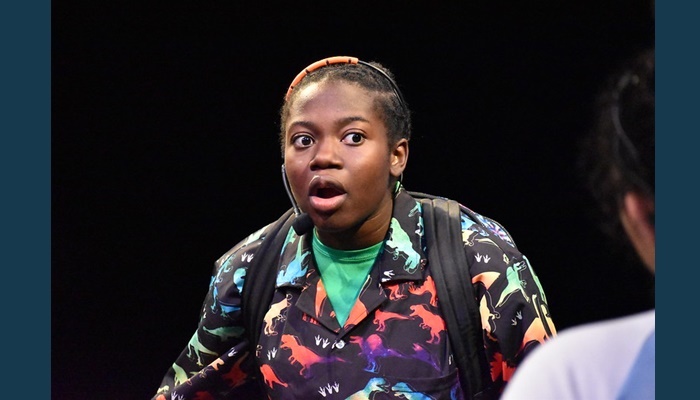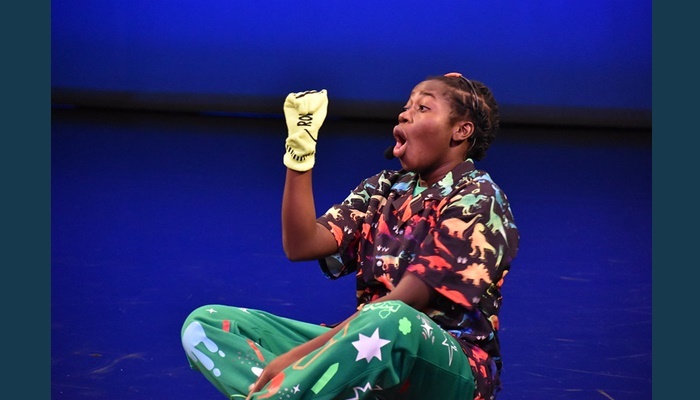SALT LAKE CITY, Utah, Oct. 20, 2023 (Gephardt Daily) — Not only is fall a very busy time for stage shows aimed at adults, but Plan-B Theatre is continuing its tradition of touring children’s shows with “Squeak,” a world premiere by Salt Lake City-based actor, writer and teacher Tito Livas.
This is the 11th annual Free Elementary School Tour serving K-3 students statewide. The play received its public premiere last month as a Ring Around the Rose offering at the Rose Wagner Performing Arts Center. “Squeak” will be available for performances in schools during the 2023-24 academic year and will go until May 2024.
Directed by Jerry Rapier, the play features two actors: one who plays Squeak and the other who takes on various roles, including the title character’s parent and teacher, as well as their classmates, Squish and Squawk.
Livas, who is the parent of two young boys, drew on his own experiences in writing the play; specifically, the challenges that one of his sons faced when he was diagnosed with ADHD at age 5.
“‘Squeak’ is the story of what I think it’s like inside his brain, the difficulties he has within himself and his interactions with others, and how to better serve his neurodivergence,” Livas said in piece written for Q Salt Lake. “I hope ‘Squeak’ will help students and teachers realize that ‘that kid’ in their class who needs constant attention, can’t sit down, can’t focus, who seems annoying and pestering, is probably not acting that way on purpose. Chances are they can’t control it.”
The production features two casts in rotation: Alec Kalled and Taylor Wallace, and Wendy “Joe” Joseph and Niki Rahimi. Occasionally, actors from both casts will perform together, respectively. I attended a free performance Saturday at the Salt Lake City Public Library Chapman Branch at 577 S. 900 West, with Joseph and Rahimi. Each public performance also featured an ASL interpreter.

Tour manager Kallie Filanda introduced the show, and the audience had a change to meet the actors, learn some basic theater terms and get ready for the interactive elements of the piece.
Filanda and the actors talk through a couple of exercises that Squeak uses when they feel overwhelmed. The first is that they imagine blowing out candles on their fingers, one at a time, which calms their breathing.
Squeak also explains that they sometimes do dragon breaths, where they breathe in through their nose, then open their eyes and mouth as big as they can, stick their tongue out, and breathe out, which shows your feelings who’s boss. Squeak invites the audience to do dragon breaths and blow out the candles with them.
Then the 25-minute show begins, and Squeak is shown getting ready for school with the help of their parent. Early in the play, they tell the audience that they have a very active brain. “Sometimes I can’t control what I do or what I say because there’s SO MUCH GOING ON IN HERE and my feelings can be pretty big,” Squeak says.
During each scene, Squeak verbally pauses the action and addresses the audience, explaining their emotions at that time.
The next scene is Squeak at school, attempting to interact with Squawk, with whom they want to be friends. Squeak tries a few different strategies to get their attention, then eventually steals their pen, which irritates Squawk, and subsequently pokes them with the pen by mistake.
“Sometimes I don’t understand if a friend is playing along with me or not,” Squeak explains. “My brain gets confused and I think we’re both having fun.”
Squeak then takes another pause while they explain to the audience how their brain works. They invite four children to say their favorite animal, then the audience is split into four sections and each section makes the noise of the animal chosen by the kid in that section.
“That’s what it’s like in my brain sometimes,” Squeak says. “The answers are there, the right thing to do is there, but I can’t always hear it because of all the other noise happening.”
Squeak explains to Squawk that they took the pen because “usually nobody plays with me unless I take something and play keep away.” Squawk says that they understand this, and uses an example of a time they felt left out, and they end the scene as friends.

The next scene follows Squeak into the classroom, where they hit another student, Squish, in the stomach while playing.
Squeak and their teacher then talk about this and come to the conclusion that Squeak will apologize. Squeak takes another pause to explain that they used to have a teacher that would pinch them when they didn’t understand Squeak’s feelings.
They say of their new teacher: “They are not a pinching teacher. They are a nice teacher. And they help me do my best. Asking me questions so they can understand my brain or my feelings lets me know they care. And it makes me feel safe. And when I feel safe, I learn better.”
Squeak then has a conversation with another student, Squish, telling them their brain works differently, and Squish tells Squeak that they have an uncle who is similar. By the end of the scene, Squeak and Squish are also friends.
The lovely thing about Livas’ script is that it portrays the way Squeak’s brain works in a very clear, uncomplicated way, that audience members both young and older can understand.
For each scene where Squeak has a challenge, there is then a sequence where the characters talk about what happened and figure out a way to resolve each situation. Thus, the children in the audience feel heard and respected, and the parents, teachers, administrators and other adults are provided with tools to be able to communicate with all different types of kids patiently.
Joseph and Rahimi do a great job portraying all the characters. Both really seem to embody the children they play, which also makes the young people in the audience really identify with them. And I loved the small touches such as when Squeak pauses, then resumes a scene, they make rewinding noises and movements.
Rahimi also has a nice arc with both the parent and the teacher from frustration with Squeak to understanding.

The production values, of course, are simple, to allow the show to tour. The costume and props design is by Arika Shockmel, and is fun and playful. Squeak wears a colorful shirt patterned with dinosaurs and a pair of sweatpants with different patterns and the word Squeak on them, while Rahimi wears a pale blue T-shirt, sweatpants and sneakers with props that differentiate her characters such as a pair of glasses or a backpack.
After the show, there is a five-minute talkback to give the audience a chance to chat about the themes and characters. There is also a study guide available, which includes suggestions about how teachers might incorporate the story into classroom activities.
Each Utah school that hosts the show will receive a copy of “All My Stripes: A Story for Children with Autism,” by Shaina Rudolph and Danielle Royer, illustrated by Jennifer Zivoin. The story introduces Zane, a zebra with autism, who worries that his differences make him stand out from his peers. With careful guidance from his mother, Zane learns that autism is only one of many qualities that make him special.
Although there are no more public shows scheduled, K-3 teachers anywhere in Utah may request a performance of “Squeak” at their school as part of Plan-B Theatre’s Free Elementary School Tour here.
The full performance is also available digitally in two formats: an audio-play podcast and a filmed stage production, with closed captioning. To request digital access, register online or email [email protected].
The digital playbill also includes an audio version of the playbill and access to the script in 18-point font.
All in all, “Squeak” does a lovely job reminding children and adults that although all our brains do not work in the same way, that diversity is a good thing and we all deserve to be understood and celebrated.













